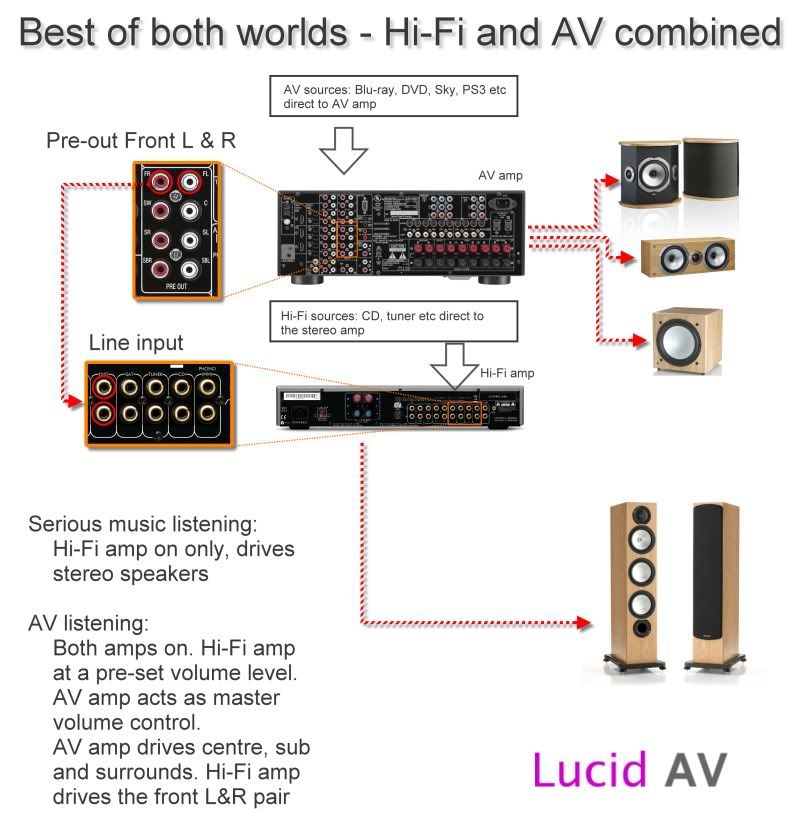so are you saying it is better to have a hi-fi amp and use the "arc" function of your tv to feed audio out, so all hdmi's go straight into tv then out through the hdmi arc into amp where sound is then output to speakers?
err... no. Where in this thread is that suggested?

If that's your idea of what we are talking about then it's no wonder you're confused and don't find there's an appreciable difference. Blimey

if someone was going for a bang for buck setup what would you advise them? because having 2 amps imo seems a terrible waste of money.
Given how confused you are about the use of pre-outs with a Hi-Fi amp then I'm a little nervous of how you are defining "
bang for buck".

Just for clarity's sake, what we were discussing was a set-up that uses a 2ch Hi-Fi amp directly driving the front stereo L&R speakers purely for analogue music sources e.g. CD player, turntable, and say PC audio in lossless via a DAC. It would also accept the front L&R feed from the pre-outs of a suitable AV amp. That AV amp would be responsible for driving only the centre, rear surrounds and sub. The AV amp wiuld handle all the digital and analogue sources that require DPL/DD/DTS and HD audio decoding. In this way the Hi-Fi chain is unaffected by all the digital processing noise of the AV amp, and that 2ch amp providing the front channel power allows the AV amp a little more dynamic headroom so you get similar benefits on the AV side of adding a power amp.
This is how they would wire together:

Does that help at all?
if someone was going for a bang for buck setup what would you advise them? because having 2 amps imo seems a terrible waste of money.
I suppose if we define "bang for buck" as getting the best Hi-Fi performance for ones money, then in that sense I would say that the two amps solution would be better than solely using some über AV amp for everything. Much though depends on what the listener is looking for and their priorities in the longer term.
As I see it, the Hi-Fi industry is pretty mature. So 2ch Hi-Fi amps aren't evolving as radically as their multi-channel AV cousins. Virtually any decent 2ch Hi-Fi amp from the last quarter century will stand up pretty well today. AV amps are a different kettle of fish. There's constant pressure to upgrade to keep pace with new technology and features. Manufacturers also face cost-cutting pressures to include an ever-larger arsenal of features at the same (or lower) price point. Somewhere in that mix the maths on AV amps doesn't add up.
Raw materials costs continue to rise. The benefit of cost reductions from Chinese manufacturing are being eroded because a) everyone else is there now, and b) wage bills in China are rising. Then there's the costs of integrating all the latest technologies and their associated licensing (HDMI, HD audio processing, 3D, video scaling, streaming features, Bluetooth/Wi-Fi/networking, AirPlay, Apps, THX, more wattage, more channels, etc etc). All of these things pull money away from what is the heart of any amplifier... a whacking great toroidal transformer and some huge high quality capacitors. It stands to reason that if you have less money to spend on those items then the quality of the final product will take a hit.
Now rewind 8-10 years. HDMI was a dot on the horizon. The AV amp market was in maturity at that point. The biggest news was DPL II and es/ex. Manufacturers were focussing on audio quality. AV amps didn't include much in the way of video scaling. Proportionately more money was spent on decent amplification. This is why an older AV amp doing DD/DTS processing can often beat its modern counterpart doing True-HD/Master Audio. The advantage of the better quality audio stream is eroded by the drop in quality of the amplification. Of course as consumers we aren't so aware of that change in the demo room because there's no old AV amp to act as a reference point. The mags are hardly likely to point it out either. Their advertisers wouldn't be so happy if they did. So it falls to AV enthusiasts to make those comparisons. This is why it's so difficult for owners of pre- and early-HDMI amps to find something new that isn't a backwards step sonically.
So, to bring this back to the point of the discussion, that's why there's an appreciable benefit running a Hi-Fi amp with an AV amp and splitting the duties. It also means that far less money needs to be tied up in the AV amp. I feel far more comfortable with the prospect of changing a £500-£600 AV amp to keep up with the latest AV processing developments knowing that it isn't going to wreck the music-side of my home system than I would swapping out a £1500+ AV receiver bought for it's musical performance.






